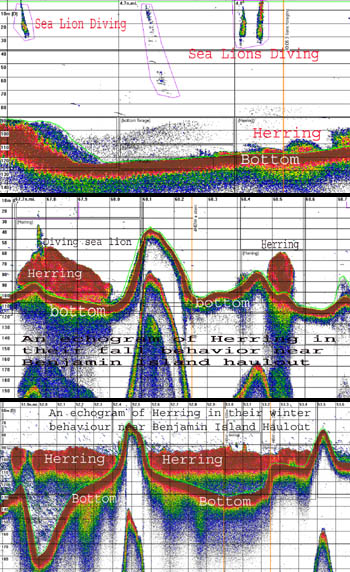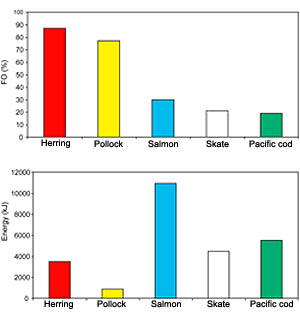Habitat Investigations Program
Overwintering Herring Survey
| |

Figure 1. Acoustic echograms of herring concentrations near the Benjamin Island
haulout showing sea lion diving behavior and herring behavior during fall and winter.
|
One hypothesis for the seasonal use of terrestrial haulouts by Steller sea lions to rest and care for their
young is that prey are seasonally available in adjacent waters. Dense, overwintering aggregations of Pacific
herring near Benjamin Island, a seasonal sea lion haulout in southeastern Alaska, are an example of
this.
Peaks in sea lion attendance between October and December correspond with peaks in herring
biomass near the haulout. Sea lion scat analyses indicate that herring are the most commonly consumed
prey item between October and December, followed by walleye pollock.
Concurrently, herring,
which undergo seasonal cycles in whole-body energy content, are most energy-rich in the fall and
early winter. The combination of large biomass and high energy content of herring in the winter results
in herring accounting for 96% of the prey-derived energy available near Benjamin Island.
Another aspect of foraging energetics is the effort associated with foraging. During the winter,
herring aggregate in dense schools on the seafloor, which facilitates a reduction in pursuit by sea lions
(Fig. 1). How easy it is for sea lions to find these aggregations influences the net benefits from foraging
trips. Predictability of prey aggregations, both in time and location, decreases search time and improves
foraging profitability.
Monthly prey surveys conducted between June 2001 and May 2004 indicate
that overwintering herring aggregations occur consistently each year near Benjamin Island. Prey
distribution in one month was a good indicator of prey distribution the same month the following
year, but only during the winter months; this was due to the formation of large schools of herring in
consistent locations within the study area.
During winter 2004–05, we are conducting
prey surveys on weekly and daily intervals to examine predictability of herring schools on shorter
time scales. Results from this fine-scale study will provide further insight into the energetic benefit sea
lions derive from Pacific herring and the balance between predation avoidance by herring and the costs
associated with searching by sea lions.
By J.J. Vollenweider and Ron Heintz
Groundfish Assessment Program
Energetic Importance of Various Fish Species As Prey for Steller Sea Lion in Southeast Alaska
|
Table 1. Comparison of he relative importance of the Steller sea lion
(Eumetopias jubatus) prey species as determined by frequency of occurrence (FO) and
energy methods. Of the 41 prey species identified in sea lion scat, the top 5 species
resulting from the energetics model are presented. |
| Prey Species |
FO Rank |
Energy Rank |
|
|
Pacific salmon
Pacific herring
Skates
Pacific cod
Mature walleye pollock |
1
2
3
4
5 |
6
1
5
7
2 |
|
|
|

Figure 2. Relative values of prey consumed by Steller sea lions shown as frequency
of occurrence (FO, top graph) and energy (kJ, bottom graph). |
|
The relative importance of various fish species as prey for Steller sea lions in southeastern Alaska was
estimated by applying energetic models to samples of sea lion scat. Relative importance of prey species
contribution to the total energy consumed by sea lions was compared to results from frequency
of occurrence analysis, a technique commonly used to examine pinniped diets.
Sea lion scats from the
Benjamin Island haulout were collected simultaneously with collections of fish prey species in adjacent
waters every 3 months during 2001–02. Biomass of prey was reconstructed from the bones in the scat
and combined with prey energy content to calculate the seasonal energy in sea lion diet by prey species.
The model was calculated using biomass-variable (BV) reconstruction, which assumes that scats represent
random biomass of consumed prey.
Pooled over all seasons, the model indicated that Pacific salmon was the most important energy
source for sea lions, followed by Pacific herring, skate, Pacific cod, and mature walleye pollock
(Table 1). In contrast, frequency of occurrence analysis indicated that herring was the most important
prey item, followed by three size classes of pollock (mature, juvenile, and young-of-year (YOY),
and skates.
The most important prey species varied amongst seasons, however. For example, in October
2001, herring and pollock were consumed in the highest numbers; however, they were less important
sources of energy than salmon, cod, and skates (Fig. 2). Our model of Steller sea lion energy consumption
increases the utility of scat data beyond providing a numerical abundance of prey in sea lion
diet to that which is most important to predators, the sources of dietary energy.
By J.J. Vollenweider, M. Sigler, D. Csepp, and J. Womble

|

|
Quarterly sidebar
AFSC Quarterly Research Reports Oct-Dec 2004
Contents
Feature
Items
ABL Reports
NMML Reports
RACE Reports
REFM Reports
Quarterly Index
Quarterly Home
|

